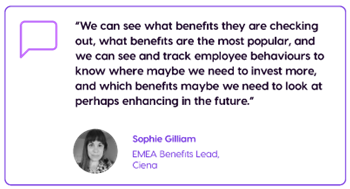
Blog, Employee Benefits
Metrics that matter: how to measure employee benefits success
01-02-2024
In recent years, the significance of reward and benefits have surged, becoming an increasingly important way to set your organisation apart and create a compelling Employee Value Proposition that makes people want to join, and stay with, your mission.
Reward leaders are already moving beyond the annual benefits enrolment stats as the defining KPIs; elevating employee benefits out of the once-a-year selection window and turning them into an everyday resource for employees, and an everyday part of the EVP for employers.
However, the priority for reward and benefits leaders is to navigate the data challenges they’re facing and understand if their benefits programme is having the intended impact. While a huge 76% of organisations can’t show ROI on benefits investments, a further 61% can’t measure logins to their benefits platform and 45% can’t analyse their total spend on benefits. So, how can you begin to understand if your benefits scheme is successful or not?
The data deficit in employee benefits and wellbeing
Currently, less than half of organisations are using data to assess the impact of employee benefits on wellbeing, to gather feedback from employees, or to measure benefits engagement. Most are a long way from being able to benchmark their offering against their competitors.
And it’s all very well having lots of data – but being able to turn it into actionable insight is where the strategic value lies. Three quarters (76%) of benefits and HR leaders report that they face challenges in turning data into actionable insight. They are held back by budgetary constraints, fragmented and disparate data, outdated technology, and lack of appropriate resources, partners and technology vendors. As a result of this data challenge, two thirds (66%) of HR and benefits leaders worry that their organisation is lagging behind its competitors in how it uses data and insight to provide employee benefits.
Actionable insights in benefits can deliver better outcomes – for the business and employees
Virtually all (99%) benefits professionals believe that data-driven benefits and reward can be used more strategically to deliver better outcomes for organisations and their people.
Some of the payoffs include improved engagement and retention (48%), an enhanced employer brand (42%), increased ability to attract high quality talent into the business (41%), improved employee wellbeing through tailored advice (40%), less administration (37%), and even reduced benefit costs (27%).
So what metrics should you adopt?
To help you demonstrate success, here are the 7 questions we think you should be asking yourself about your benefits scheme:
- Are employees engaging with the benefits on offer? Even if employees aren’t selecting every benefit, engagement with benefits pages shows that they’re interested in what’s available.
- Have you got appropriate benefits take-up targets in place? Do you know what good engagement looks like for each benefit in your scheme? Some benefits like a Menopause benefit will only be relevant to specific demographics – the overall numbers might be small, but if it’s resonating with the intended audience then it’s a success. You should be able to drill down by different employee demographics and locations. And to supplement the data, capturing anecdotal employee stories that demonstrate the impact of benefits is a great way to show how benefits are improving employee outcomes.
- What do the communications statistics look like? Click through rates will indicate which messages have resonated mostly strongly with employees and which messages need reworking; a follow up campaign could help drive further employee engagement.
- What do employees say about their benefits and the experience of selecting them? Regular surveys that capture employee feedback are a great way to demonstrate what’s working well and highlight areas for improvement. You can capture information around how benefits are supporting their financial, emotional, and physical wellbeing, the types of benefits that appeal to them most, how the scheme compares with their previous employer, what they think of their benefits platform, and much more.
- How often are employees logging into the platform? If employees are engaging with their benefits on a regular basis (outside of the annual enrolment period), they’re starting to use them as an everyday resource.
- How does your benefits engagement compare to other organisations in your industry? Are you achieving similar benefits take-up to competitors? What does your benefits spend look like? And are you offering a competitive range of benefits compared to the rest of the market?
- Has employee engagement gone up? Has employee attrition gone down? Although this might not be solely attributable to your benefits programme, can you correlate employee acquisition, engagement and retention with benefits engagement?
By better understanding your people, you’ll be able to continually optimise and improve your reward offering.

Priorities for Reward leaders in 2024
As we stride into 2024, employers are challenged with swiftly understanding and meeting employees’ evolving expectations. Simultaneously, prioritising the integration of reward, benefits and wellbeing into the strategic heart of the organisation is key to proving the value of employer initiatives and demonstrate the function’s potential as a lever for commercial success.
Making use of available technology, tools, and data will be key for many successful organisations to unite the employee experience, drive engagement, demonstrate ROI, and continue to optimise their strategies. In this evolving landscape, it’s important to invest in the right tech solutions to help paint a clear picture of what employees want, and successfully deliver this.
To help you continue to grow, innovate, and stretch your reward budget further, check out our full guide on ‘The 5 things we bet your CPO will ask you in 2024’.

Ryan Hall
Commercial Lead Customer Success, Benefex


